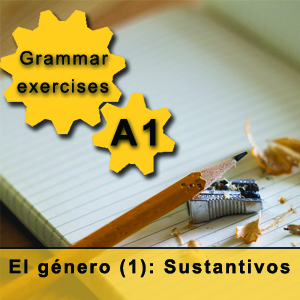The gender of nouns in Spanish

El alfabeto español (3)
September 29, 2016
Singular and plural nouns in Spanish
September 30, 2016Use the following link to download this grammar exercise
In this exercise we are going to focus on the study and practise of the gender of nouns in Spanish, which are classified as either masculine or feminine. In case you do not know, gender is a characteristic of nouns, articles, adjectives, participles and pronouns which classifies them into two groups – masculine and feminine. You should not confuse this with the sex of living beings!
To help you with the practice of the gender of nouns in Spanish we have put together an exercise that we have divided in two parts, one part is theoretical and the other part are exercises to practise.
Basic rules of the gender of nouns in Spanish
In the theoretical part you can see the basic rules, which are summarized below.
Most nouns have a single male or female gender form. The general rule is that words ending in –o are masculine, while most of the words ending in -a are feminine. Do not forget that words ending in -e may be masculine (eg, el coche = the car) or feminine (eg, la llave = the key).
However, within the theoretical framework, there is a special mention to the exceptions to the general rule. That is, nouns ending in -a that are of the masculine gender (examples: el tema = the subject, el mapa = the map) and, on the contrary, nouns that are of the feminine gender and end in -o (example: la moto = motorcycle, la mano = hand).
In addition to that general rule there are others, for example that all words ending in -ción are feminine, like all words ending in -ema are masculine. Here are some examples; la canción = the song, la relación = the relationship, la estación = the station…or el tema = the subject, el teorema = the theorem, el sistema = the system.
Finally, some nouns that name people or animals have one form for the masculine and another form for the feminine. Here are some examples;
- Changing the ending of the noun from a masculine o to a a – abogado/abogada, vecino/vecina, gato/gata
- Adding to the masculine one of these endings – isa, esa, ina – sacerdote/sacerdotisa, alcade/alcaldesa/ gallo/gallina.
- Changing the ending of the masculine: emperador/emperatriz
- Using different words for the masculine and the feminine; madre/padre, caballo/yegua
We encourage you to complete the exercise and then compare your answers with the solutions that can be found at the bottom of the page. You can also ask our teachers in our Madrid Spanish school. If you corrected your errors derived the gender of nouns in Spanish you will have solved a basic problem in learning this language. A misuse of the genre of nouns negatively affects the structures of sentences. We hope that your practice goes well and we wish you the very best of luck with your studies.





